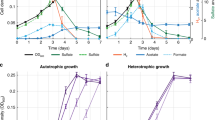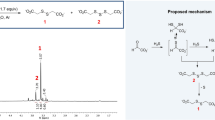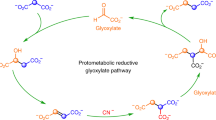Abstract
THE synthesis of cysteine in micro-organisms from inorganic sulphur sources has been studied for some time, and the available evidence suggests that sulphate sulphur is reduced to the thiosulphate or sulphide state prior to its introduction into the carbon chain of cysteine1–3, although some investigators have postulated that the formation of sulphur–carbon linkage occurs at the sulphite stage4. Working with mutant strains of Aspergillus nidulans, Hockenhull2 suggested that thiosulphate is the form in which sulphate sulphur combines with the carbon skeleton. Based on the observations that cysteine-S-sulphonate supported good growth of all the thiosulphate-requiring mutants tested and that growth of these strains on thiosulphate was enhanced by the addition of serine, he concluded that thiosulphate first reacts with serine to form cysteine-S-sulphonate as an intermediate and cysteine is formed from the latter by hydrolysis. The same possibility was also postulated by Shepherd4, although the involvement of thiosulphate in the main route of sulphate assimilation was denied by this investigator. Schlossmann and Lynen5, on the other hand, reported the occurrence in yeast of a pyridoxal phosphate-dependent enzyme catalysing the condensation of hydrogen sulphide with serine to form cysteine. The present communication describes more convincing evidence in favour of the cysteine-S-sulphonate pathway in A. nidulans.
This is a preview of subscription content, access via your institution
Access options
Subscribe to this journal
Receive 51 print issues and online access
$199.00 per year
only $3.90 per issue
Buy this article
- Purchase on Springer Link
- Instant access to full article PDF
Prices may be subject to local taxes which are calculated during checkout
Similar content being viewed by others
References
Lampen, J. O., Roepke, R. R., and Jones, M. J., Arch. Biochem., 13, 55 (1947).
Hockenhull, D. J. D., Biochim. Biophys. Acta, 3, 326 (1949).
Horowitz, N. H., “Adv. Genet.”, 3, 33 (1950).
Shepherd, C. J., J. Gen. Microbiol., 15, 29 (1956).
Schlossmann, K., and Lynen, F., Biochem. Z., 328, 591 (1957).
Fries, N., Nature, 159, 199 (1947).
Pontecorvo, G., Cold Spring Harbor Symp. Quant. Biol., 11, 193 (1946).
Kolthoff, I. M., and Stricks, W., J. Amer. Chem. Soc., 73, 1728 (1951).
Baek, S., and Sato, R., (in preparation).
Author information
Authors and Affiliations
Rights and permissions
About this article
Cite this article
NAKAMURA, T., SATO, R. Cysteine-S-sulphonate as an Intermediate in Microbial Synthesis of Cysteine. Nature 185, 163–164 (1960). https://doi.org/10.1038/185163a0
Issue Date:
DOI: https://doi.org/10.1038/185163a0
This article is cited by
Comments
By submitting a comment you agree to abide by our Terms and Community Guidelines. If you find something abusive or that does not comply with our terms or guidelines please flag it as inappropriate.



